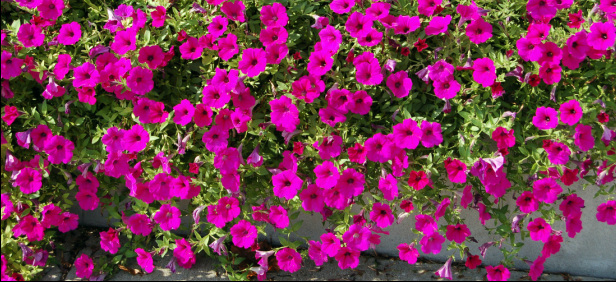How to Grow and Care for Petunias
I didn't always like petunias. I thought they were for old ladies. Perhaps I was right. I find the older I get, the more these cascading flowers appeal to me. I like to think it is because today's wave petunias create a cascading mass of color - but I can't be sure. I usually plant them in my half whiskey barrel, but one planter is never enough. I add hanging baskets and buckets overflowing with petunias on my back porch, too. I tell people they are to attract my hummingbirds, but truth be known, I simply love the scent of petunias wafting in the night air.
Lighting
Experts will tell you that petunias love full sun and that you should plant them in an area that receives direct sunlight for at least 6 to 8 hours a day. I'm sure that advice works in some areas, but here in my Maine garden they do better in bright morning light and afternoon shade. Colors are brighter and blooms are larger and more prolific.
Last summer, I actually tested my theory - the fact that it was an accident really doesn't matter. I bought two flats of identical wave petunias. I planted one in a planter that received only morning sun for a few hours each morning. The second flat was planted in my whiskey barrel in direct sunlight from morning until sunset. Within weeks the petunias in morning sun flourished producing rich, green foliage and abundant deep-rose blooms. Those in full sun survived but could not compete with either size or color.
Watering
Petunias, especially those grown in containers, require consistent watering - often once or twice a day, depending on the size of the plant, rate of growth and weather conditions. I make a habit of watering mine every morning and checking them again in the evening for any signs of wilting or drying. Water until water runs freely through the bottom of the pot to ensure that all soil is moistened.
Fertilizer
Feed petunias water-soluble fertilizer designed for flowering plants every 10 to 14 days. I'll be honest with you, I use Miracle-Gro for vegetables on mine and they respond with lush, vigorous vines with vibrant blooms. Petunias are heavy feeders and need the added nutrients to produce healthy foliage and blooms.
Deadheading
Some petunias are marketed as self-cleaning, but most require daily deadheading to keep them looking good and producing new flowers. I deadhead mine in the morning before watering, but you can do it any time of day. Simply snap the faded bloom from the plant. This tricks the plant into thinking it has not produced enough blossoms to set seed. It responds by producing more blooms.
Special Problems
Hot, dry weather may cause your petunia plants to "dry up" prematurely. Lack of water for a day or two can result in dry, crumbly leaves and shriveled flowers. If this happens to you, you can typically revive your petunias and force a new flush of blooms.
